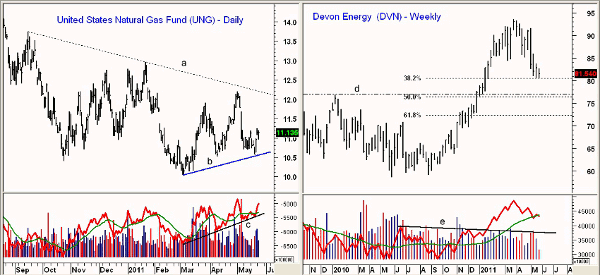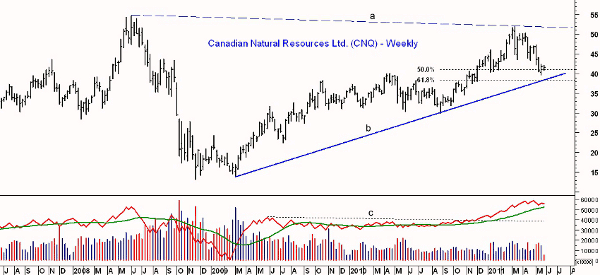Natural gas has been hard hit in recent years, but the primary natural gas ETF and several leading stocks are showing signs of a bottom, offering favorable long entries with controlled risk.
From the 2008 high of $13.61, natural gas futures plunged to a low of $2.50 just 14 months later. Over the past two years, the ranges have narrowed but have stayed near historically low levels.
Estimates indicate that the current amount of natural gas available for production would be enough to last 100 years under current domestic consumption. With natural gas so cheap, about 40% of natural gas production is sold for less than it costs to produce.
The prolonged price slump has caused many companies to concentrate on drilling for oil instead of gas because the profit margins are much more attractive for oil. It is possible that decreasing natural gas supply will be met by increasing demand.
As I noted in early May, the weekly volume analysis on the United States Natural Gas Fund (UNG) indicated that an intermediate-term bottom was forming. Also, several of the larger natural gas companies have now corrected to strong support.
Natural gas was in the news on Tuesday, as El Paso Corporation (EP) was up 7% for the day on very heavy volume after it announced that it will split into two companies.
Chart Analysis: The daily chart of the United States Natural Gas Fund (UNG) shows that the support in the $10.60 area (line b) was tested in the past two weeks before UNG moved back above $11.00.
- There is next resistance for UNG at $11.50 with the previous peak and the daily downtrend (line a) in the $12.20 area. Longer-term resistance is in the $13.70-$14 area
- The daily on-balance volume (OBV) has been rising more sharply than prices, line c, and shows a pattern of higher highs. The weekly OBV (not shown) has turned up and could move back above its weighted moving average (WMA) if volume increases by the end of the week
- Once below support at $10.57-$10.60, there is stronger support in the $10.00 area
Devon Energy (DVN) is a $35 billion oil and gas company that peaked at $93.55 in late March but has since corrected 14% from the highs. The early-May report that its first-quarter earnings were down by 65% did not help.
- The weekly chart of DVN shows that the 38.2% support at $80.50 has been tested. There is even more important support at $76.20-$77, which corresponds to the early-2010 highs and the 50% retracement support
- The weekly OBV did confirm the March highs, and while it is now back below its weighted moving average, it is still above the breakout level (line e)
- The daily volume (not shown) is negative, as it is below its WMA
- There is initial resistance at $86.25 and then more important resistance in the $91.50 area
NEXT: 3 Favorable Long Plays for Natural Gas
|pagebreak|Canadian Natural Resources Limited (CNQ) is a $45 billion Canadian oil and gas company that reached a high of $52.04 in early March before reversing. CNQ violated the $40 level last week, which represents a 25% decline from the highs.
- The 50% retracement support, as calculated from the August 2010 highs, has been violated, and the April 2010 highs have been tested
- The 61.8% support is at $38.50 along with the weekly uptrend, line b, which goes back to the 2009 lows
- The weekly OBV has held well above its rising weighted moving average, which is a sign of strength. The weekly OBV completed a major base formation when it moved through resistance, line c, last December
- The daily volume (not shown) is still negative, as it is below its WMA
- Initial resistance is now at $42.50 and then $44.50, while a move above $47.32 will confirm that the correction is over
What It Means: The weekly technical action in UNG is consistent with the formation of a significant bottom. A strong weekly close above the May highs at $12.20 will confirm that the lows are in place.
Both DVN and CNQ have positive weekly volume patterns and are now near good support, making the risk/reward favorable on new long positions.
This is in contrast to the negative weekly technical outlook on some of the largest oil companies (see “Big Oil’s Big Top”).
How to Profit: Previous buyers should be 50% long United States Natural Gas Fund (UNG) at $10.77 and 50% long at $10.44 with a stop at $9.89. On a move above $11.90, raise the stop to $10.47. Those not long could take a partial long position at $10.94 or better with a stop at $10.39 (risk of approx. 5%).
For Devon Energy (DVN), go 50% long at $80.26 and 50% long at $78.46 with a stop at $75.93 (risk of approx. 4.2%). On a move above $85.60, raise the stop to $79.82.
For Canadian Natural Resources Limited (CNQ), go 50% long at $40.62 and 50% long at $39.92 with a stop at $37.84 (risk of approx. 6.0%). On a move above $44.10, raise the stop to $39.42.




















